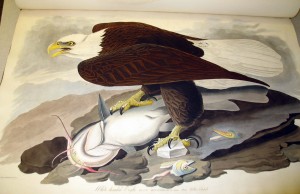 “The figure of this noble bird is well known throughout the civilized world, emblazoned as it is on our national standard, which waves in the breeze of every clime, bearing to distant lands the remembrance of a great people living in a state of peaceful freedom. May that peaceful freedom last forever!
“The figure of this noble bird is well known throughout the civilized world, emblazoned as it is on our national standard, which waves in the breeze of every clime, bearing to distant lands the remembrance of a great people living in a state of peaceful freedom. May that peaceful freedom last forever!
[there follows a vivid and dramatic account of an eagle hunting a swan, an many observations of their habits]
. . . Before steam-navigation commenced on our western rivers, these Eagles were extremely abundant there, particularly in the lower parts of the Ohio, the Mississippi, and the adjoining streams. I have seen hundreds going down from the mouth of the Ohio to New Orleans, when it was not at all difficult to shoot them. Now, however, their number is considerably diminished . . .
In concluding this account of the White-headed Eagle, suffer me, kind reader, to say how much I grieve that it should have been selected as the Emblem of my Country. The opinion of our great Franklin on this subject, as it perfectly coincides with my own, I shall here present to you. ‘For my part,’ says he, in one of his letters, ‘I wish the Bald Eagle had not been chosen as the representative of our country. He is a bird of bad moral character; he does not get his living honestly; you may have seen him perched on some dead tree, where, too lazy to fish for himself, he watches the labour of the Fishing-Hawk [i.e., the Osprey]; and when that diligent bird has at length taken a fish, and is bearing it to his nest for the support of his mate and young ones, the Bald Eagle pursues him, and takes it from him. With all this injustice, he is never in good case, but, like those among men who live by sharping and robbing, he is generally poor, and often very lousy. Besides, he is a rank coward: the little King Bird, not bigger than a Sparrow, attacks him boldly, and drives him out of the district. He is, therefore, by no means a proper emblem for the brave and honest Cincinnati of America, who have driven all the King Birds from our country; though exactly fit for that order of knights which the French call Chevaliers d’Industrie.'”
–J. J. Audubon, Ornithological Biography, I (1831), 160-168 [excerpted].